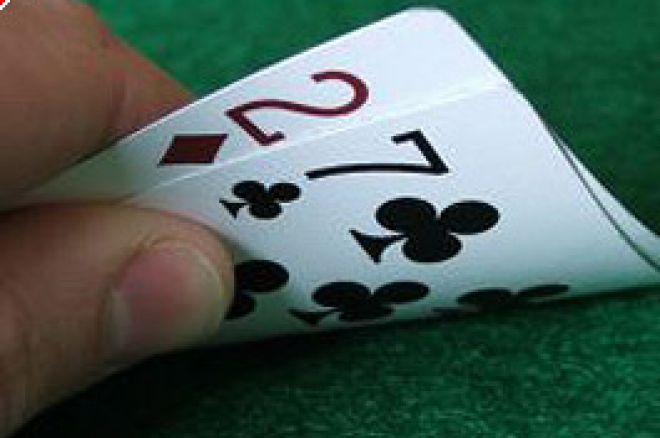The 'Other' Games of Poker: Pot Limit Omaha 8 or Better

This week's "other" poker game is a curious hybrid of two familiar poker forms. Pot-limit Omaha 8 or better (PLO8) combines the volatility and enormous pots of pot-limit Omaha hi and the patience and finesse required in limit Omaha hi-lo. Though one would be hard-pressed to find a live PLO8 game (splitting up all the huge pots by hand alone would slow the pace of play to a crawl) the game is thriving online. Poker Stars almost always has multiple tables running at the $3-6 ($600 max) level and lower while even higher limit games populated by pros like Mike Matusow and John Juanda will occasionally go off on Full Tilt. Primarily, online PLO8 is played today by the low-to-mid limit set, and its players typically fall into one of two categories: very good or appallingly bad. Let's make sure you stay out of that latter category, shall we?
Rules
The action in PLO8 proceeds exactly like any other Omaha ring game, except that all bets and raises are capped at the size of the current pot. Players receive four down cards to start, and must use two and only two of them to combine with three and only three of the five board cards to make their best high hand and low hand. Half of the pot is awarded to the best high hand, with the other half going to the best low hand. There is not always a qualifying low hand in PLO8. Unless the board contains three cards 8 or lower, there is no possible low hand to be made and the entire pot is awarded to the best high hand. Players may use different combinations of their hole cards and the board to make each hand. For example, a player with the Ad-2d-3c-5h on a board of 2s-Jd-7d-8h-Kd would use the Ad-3c from their hole cards and the 2s-7d-8h from the board to create their low hand, and play the Ad-2d along with the Jd-7d-Kd for the high.
Basic Strategy/Starting Hands
Quality starting hands in PLO8 are very different than their limit O8 counterparts. Many beginning and intermediate limit O8 players often adhere to an "A2 or bust" strategy when it comes to starting hands. In PLO8, think "backup low cards or bust" instead. These other low cards give you multiple ways to win the low and avoid being counterfeited for half the pot on the later streets. Premium starting hands in PLO8 are those that give you strong potential to scoop the entire pot. Suited aces with multiple wheel cards (Ac-2h-3c-4h) or A-A-2 plus another backup wheel card (A-A-2-4, A-A-2-5) are some of the strongest PLO8 starting hands. The more coordinated all four of your cards are (suited, connected) the stronger your hand. Sixes are also valuable low cards to have in a hand that contains other wheel cards as many times your opponent will make a wheel for high and low, and you'll out-pip him for the high with a six-high straight. For example, if you hold Ah-2c-3h-6d and your opponent holds Ac-2h-3s-5c on a final board of Kc-2s-4h-Jc-5s, you would win 3/4 of the pot (all of the high pot with the six high straight, and the low pot would be split with both of you playing wheels). Your opponent is also highly likely to pay off a huge river bet in this situation as a wheel for high and low in this situation is nearly impossible to let go.
Hands like Ac-2h-Ks-Qd that might be playable in limit O8 are much less powerful in PLO8. Say the flop is 5s-7s-Jd. You have flopped the nut low draw, but have no way to make a high hand. Are you willing to potentially call pot-sized bets on the next three betting rounds just to chase a one-way hand that could potentially be counterfeited? Make sure all four of your cards are working together. A hand like Ac-3h-Jh-Js might be worth a limp in limit, but should sail straight into the muck in pot-limit. Something like 2d-3d-4h-5s could be worth a raise in pot-limit, but would be viewed as a "trouble hand" in limit.
PLO8 is a game of big pots and nut-nut hands. Patience and tight play is rewarded. Substantial wins in PLO8 happen when you make a huge high hand with the nut low and your opponent calls you on the river with a strong, but lesser high hand and the nut low. In these extremely profitable situations, you'll be winning 3/4 of the pot.
Here are a few basic ideas to consider while developing your PLO8 game:
1. It's OK to limp in.
It's a good idea to play more hands preflop in PLO8 than you would in LO8, but most of the time you should be limping in with them instead of raising, especially when you're out of position. If you have something like A-A-2-4 in early position, you want to encourage other players to enter the pot with A-2-X-X or A-3-X-X, not discourage them. Many of them will be unable to let go of their low hands on the later streets and you'll be in that excellent 3/4-ing situation where you'll split the low but scoop the high.
2. Hit it or quit it.
In PLO8 you're looking for a flop that fits your hand perfectly. Typically this will include a made low or a nut low draw along with two pair or a set as well as redraws to the nut straight or flush. Holding the Ad-2s-4c-Kd, a flop of 3d-5d-Kh is an excellent fit for your hand. Along with your top pair, top kicker, you have the nut flush draw and a straight draw for high and the nut low draw. If you don't hit the flop hard, save your money and wait for a better situation.
3. You will be folding a lot more hands on the flop in PLO8 than in LO8.
Limp in and fold, limp in and fold. This may seem like weak, passive play, but it's often proper strategy in PLO8. While a gutshot straight draw and a nut low draw on the flop might be worth calling one bet in a multi-way pot in a limit game, you'll likely be facing a pot-sized bet in PLO8. There is no shame in folding. Let it go and move on to a hand where you actually flop something strong.
4. Don't ever draw to a one-way hand.
Building a big pot with only a one-way hand is chip suicide. You are betting ONLY to get your money back, or even less if one of your opponent makes the same nut low! Always have multiple possibilities going for you after the flop, or get out of the pot.
5. You will sometimes have to fold the "current" nuts
Inexperienced players at this game have great difficulty mucking non-nut (yet strong) high hands, like a 'broadway' straight on a board that is paired or flushing. But make no mistake, you will have to make this fold on a regular basis in order to be a winning PLO8 player. Let's say the flop is the 6c-8h-9c and you completed in the SB with the As-4h-7s-Td. You have flopped the nut straight, but this hand is already incredibly vulnerable. Now you have to decide whether to check or bet out with the current nuts. Consider not only your hands, but the hands your opponents could potentially call you with (the nut flush draw, 2 pair, the nut low draw). Let's say you decide to throw out a pot-sized bet and one opponent calls you from position with the Ac-2c-3h-4s. Even with the current nuts, you are still a 3-2 dog to the A-2-3-4! Think of all the bad turn cards that could come. Any A, 2, 3, 4, 5, or 7 qualifies a low hand. Any club could kill your high (and it would in this example). Any Q puts a higher straight out there and pairing the board with another 6, 8, or 9 could improve a player with two pair to a full house. So... you're going to play this hand just praying that an A, 2, 3, 4, 5, 6, 7, 8, 9, Q, or club doesn't fall? Get out now, while you have very little invested�C it could save you an entire buyin by the time the hand is complete.
With the high turnover and constant influx of new players, online PLO8 is a great bet for a tight, aggressive player looking for some steady bankroll growth. Be patient, start small, and get ready to fold a lot at first, but I promise�C once you scoop that first 100BB pot against a total donkey holding only the second nut low, you'll be hooked.








